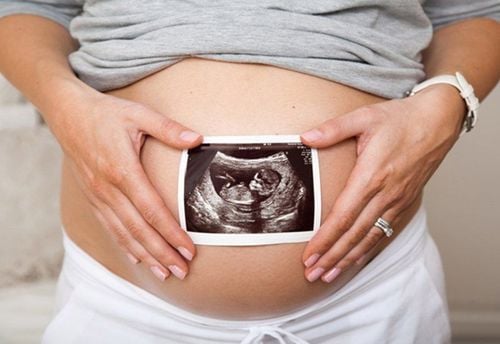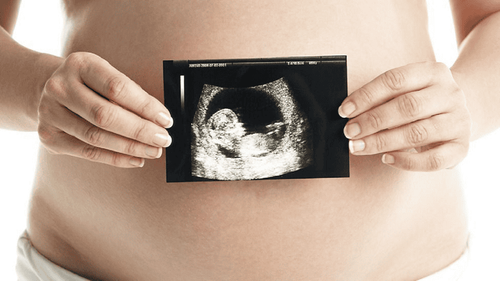This is an automatically translated article.
The article was professionally consulted by Specialist Doctor I Le Hong Lien - Department of Obstetrics and Gynecology - Vinmec Central Park International General Hospital. Doctor Lien has over 10 years of experience as a radiologist in the Department of Ultrasound at the leading hospital in the field of obstetrics and gynecology in the South - Tu Du Hospital.
Amniotic fluid nourishes and protects the fetus during pregnancy. Through the survey of the color and volume of amniotic fluid, the doctor can assess the health status and some diseases of the fetus.
1. What color is amniotic fluid?
In the early stages of pregnancy, the amniotic fluid is clear white. As the fetus grows, the color of the amniotic fluid will become whiter because it contains many substances (substances that cling to the baby's skin to help protect the baby, a form of fat). The fetus is mature enough (from the 38th week), the amniotic fluid will be milky white, almost like rice water.
Abnormal amniotic fluid color can be a bad warning sign of fetal health.
Amniotic fluid is greenish yellow: there may be fetal hemolysis or fetal growth retardation in the uterus. Amniotic fluid is dirty or has a green mossy color or contains meconium of the baby: The fetus is severely weakened in the womb, life-threatening. The amniotic fluid is cloudy green like pus, has a bad smell: is an infection of the amniotic fluid, the baby has a high risk of infection in the uterus... Amniotic fluid is red-brown: it is possible that the fetus has been stillborn. Amniotic fluid color is seen through amniocentesis in cases where the cervix dilates larger than 1cm or amniocentesis through the abdominal wall. When amniotic fluid tamponade or spontaneous rupture of membranes, the color of amniotic fluid can be seen accurately and clearly.

2. Abnormalities in amniotic fluid volume
The amount of amniotic fluid increases gradually from 250 to 800ml during 16-32 weeks, then stabilizes at this level until 36 weeks and then gradually decreases to about 500ml when it comes to due date. In fact, people use ultrasound to evaluate how little or too much amniotic fluid there is; and there are 2 ways of measuring: either directly measure any amniotic space (measurement of the maximum diameter of the cavity or measure the volume of the cavity) or divide the chamber from the arch into 4 parts and evaluate the amniotic cavity in all 4 parts , then added together to get the amniotic fluid index (AFI). Clinical assessment is based on abdominal palpation, which shows that the uterine height does not correspond to gestational age (smaller when there is less amniotic fluid or more when there is more amniotic fluid), whether the abdomen is firm or loose, but these signs are also present. It can be due to other reasons such as large or malnourished children, multiple pregnancies, too thin or too overweight. Therefore, ultrasound remains the most accurate assessment.
Trắc nghiệm: Mẹ bầu nên làm gì khi bị thiếu ối?
Nước ối đóng vai trò quan trọng trong sự tồn tại và phát triển của thai nhi. Trường hợp lượng ối quá ít (thiểu ối) thì sẽ tiềm ẩn những nguy cơ như gây thiểu sản phổi, chèn ép dây rốn,... Trả lời các câu hỏi trắc nghiệm sau sẽ giúp bạn có những cách phòng ngừa và điều trị kịp thời.The following content is prepared under supervision of Thạc sĩ, Bác sĩ y khoa, Tạ Quốc Bản , Sản phụ khoa , Khoa Sản phụ khoa - Bệnh viện Đa khoa Quốc tế Vinmec Phú Quốc
2.1. Polyhydramnios Polyhydramnios is an excess accumulation of amniotic fluid. Pregnant women are diagnosed with polyhydramnios when the amniotic fluid index (AFI) through ultrasound is more than 25 cm, the largest amniotic cavity is > 8 cm. Polyhydramnios is common in multiple pregnancies and some abnormalities of the fetal central nervous system such as hydrocephalus, anencephaly, meningocele, spinal bifida... Polyhydramnios can also be caused by pathological causes of the amniotic membrane, umbilical cord placenta, placental edema, fetal enlargement, maternal disease such as maternal diabetes, .. or idiopathic.
In fact, about 2/3 of cases of polyhydramnios have no known cause. Causes of maternal polyhydramnios can be due to:
Maternal diabetes: Polyhydramnios is detected in 10% of pregnant women with diabetes, especially in the third trimester of pregnancy. When you have diabetes and your blood sugar is not well controlled, your baby may produce more urine. Therefore, lowering your blood sugar will reduce the amount of amniotic fluid. Pregnant women with dystonia. However, this is quite rare during pregnancy. Mothers carrying twins or multiples: Polyhydramnios can occur because the metabolism between the two fetuses is not balanced (one fetus has less amniotic fluid while the other has more amniotic fluid). Abnormalities in the fetus: The baby will stop the process of drinking amniotic fluid - urinating, leading to an excess of amniotic fluid. This condition occurs when malformations in the fetus such as cleft palate, pyloric stenosis... Other factors that may increase polyhydramnios are: Anemia in the fetus; fetal infection, blood type incompatibility between mother and baby...

Effects of polyhydramnios on fetal development and health: polyhydramnios occurs in about 1% of pregnancies. Polyhydramnios makes the fetus easy to move in the uterus, so it can cause the umbilical cord to wrap around the neck, the umbilical cord to knot, and abnormal position. Polyhydramnios causes the mother's abdomen to swell, making it difficult for pregnant women to breathe, causing uterine contractions and premature labor, which increases the baby's birth mortality rate. During labor, polyhydramnios is the cause of prolonged labor, making the baby more likely to fail, and the mother has uterine atony, causing postpartum hemorrhage. Besides, polyhydramnios can cause sudden rupture of membranes and complications of sudden rupture of membranes are: placental abruption, umbilical cord prolapse, abnormal position and amniotic fluid embolism. These are life-threatening for both mother and child. Of course, these risks vary depending on the severity and cause of polyhydramnios. As soon as the baby is born, the excess fluid is also drained and the mother feels more comfortable immediately.
In most cases of mild hyperhydramnios there is nothing to worry about. Your doctor will tell you to have regular checkups and give you some diuretics. If the cause of the infection can be determined, it can be treated with antibiotics that are safe for the fetus.
For severe polyhydramnios, there are signs of problems related to the fetus that need to be monitored. Your doctor will closely monitor your amniotic fluid volume, if it increases too quickly you may need surgery, amniocentesis to remove the amniotic fluid.
In addition, pregnant women need to regularly visit the doctor for monitoring, and may even have to be hospitalized and intervene as soon as necessary when symptoms such as shortness of breath and chest tightness appear; Abdominal enlargement rapidly and markedly, sudden pain.
2.2. Oliguria Oliguria, a condition in which amniotic fluid is less than normal, when the amniotic index (AFI) is less than 5cm and the amniotic membrane is intact, is common in abnormalities of the urinary system and fetal digestive system. in the state of maternal malnutrition, fetal malnutrition, pregnancy past due date, premature rupture of membranes, premature rupture of membranes....
Effects of oligohydramnios on fetal development: Depending on the condition and cause and the gestational age at which the lack of amniotic fluid will affect more or less.
In case a pregnant woman has a lack of amniotic fluid in the first 3 months of pregnancy or a few weeks after, there is a possibility of miscarriage and stillbirth. At the same time, this will also affect the development and lung function of the fetus. In case the mother has a lack of amniotic fluid in the last 3 months of pregnancy, the mother can be somewhat relieved because most of them do not cause dangerous complications. The patient will be closely monitored the health of both mother and child and may be given water to replenish amniotic fluid for pregnant women. However, oligohydramnios during this stage can cause the fetal position to be reversed because there is not enough amniotic fluid needed to rotate the head downwards. Lack of amniotic fluid can also lead to premature rupture of membranes. If the water breaks, causing oligohydramnios when not in labor or at the beginning of the birth, it will infect the amniotic fluid, thereby infecting the fetus, infecting the uterus... both mother and baby are dangerous and will be affected. affect health and life. The doctor will consider the risk of amniotic fluid infection and the condition of the fetus to decide whether to intervene to help the mother deliver early. To treat oligohydramnios, your doctor will ask about your medical history and do a vaginal discharge test (Nitrazine test) to rule out amniotic fluid leakage or rupture of membranes. Then, perform prenatal ultrasound to survey and detect fetal morphological abnormalities, especially fetal urinary system pathology such as renal dysplasia, urinary tract obstruction. The patient will be advised of the benefits and complications, conduct amniotic fluid transfer procedure in case the amniotic fluid is too little to interfere with the fetal morphological investigation. In addition, amniotic fluid can be taken simultaneously for immunological and genetic testing to reduce compression of the umbilical cord and fetal movement. In case of associated intrauterine growth retardation, fetal echocardiography should be performed. , Doppler ultrasound (AFI, middle cerebral artery Doppler), obstetric monitor...

Abnormalities in the volume and color of amniotic fluid can cause severe consequences for the health of the fetus as well as psychological anxiety for pregnant women. Therefore, in addition to a reasonable diet and adequate water intake, pregnant women also do not forget to have regular antenatal check-ups according to the instructions of the obstetrician, to detect early and promptly treat any abnormalities. can often occur during pregnancy.
Department of Obstetrics and Gynecology - Vinmec International General Hospital has solved many difficult cases such as: polyhydramnios, placenta accreta, knotted umbilical cord, preterm pregnancy... To make the pregnancy process more convenient, Vinmec has rolled out PACKAGE Maternity Packages, which include prenatal, intrapartum and postpartum care services. Pregnant women are monitored and carried out all necessary tests and ultrasounds to detect pregnancy abnormalities early. The birth will be "gentle" like going on vacation, at the hospital, there are fully equipped for mother and baby.
Vinmec International General Hospital gathers a team of highly qualified doctors at home and abroad as well as the quality of ultrasound machine system, modern equipped medical equipment, main prenatal examination procedures. Accurately, science will handle abnormalities during pregnancy and labor quickly, helping women have the safest pregnancy.
Please dial HOTLINE for more information or register for an appointment HERE. Download MyVinmec app to make appointments faster and to manage your bookings easily.















